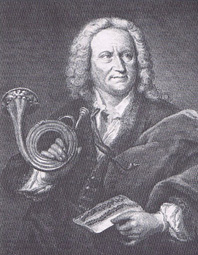Programme notes March 2008
Although Bach was usually quite specific about which instruments he wanted playing from which parts, some of the indications on his brass parts are still a mystery to us.
Along with the usual trombe, tromba, principale, clarino, trompette etc, he also wrote for corne, lituus, tromba da tirarsi, and corno da tirarsi.
Corne was written on a part for the zink (cornetto); the lituus was a type of horn or coiled trumpet we think, possibly wooden in some cases, but that is another story.
The tromba da tirarsi, a one-legged relative of the trombone, was a descendant of the medieval Zug Trompete or Busaun.
What the corno da tirarsi was, we simply don’t know. Or in academic terms: opinion is divided.
A few of Bach’s cantatas call for a natural brass instrument pitched in Bb or A (the same length as a tenor trombone but played in the trumpet register) with the facility to shift quickly in pitch by about three-quarters of a tone (about 27 cm), i.e.: a slide of some sort; but on a coiled, conical instrument?
The most practical theory to date is that the corno da tirarsi was a horn with a layout similar to the late 18th century “Inventions” horn, with a freely-moving, double (cylindrical) tuning slide positioned diametrically across its circular body. An instrument similar to this, dated at a controversially late 1776 by German maker Haltenhoff, is in the Conservatoire collection at the Cite de la Musique museum in Paris. It has not yet been copied.
Cantatas were written for the corno da tirarsi only in Leipzig and seem to coincide with the service of Gottfried Reiche, Bach’s most celebrated Stadtpfeiffer. Subsequent revisions of such works after Reiche’s death were re-scored for organ, zink or oboe, suggesting that it was an instrument unique to him. Musicologists continue to investigate this mystery. In the meantime, this performance will be played on the tromba da tirarsi with extra crooks, transposing it down a fourth from D to A.
A seminar about the elusive lituus and a lecture by Olivier Picon on the corno da tirasi, will be held at the Schola Cantorum Basiliensis in January 2009.
Mike Diprose
March 2008
Nederlandse samenvatting
Maart 2008
Bach schrijft in een aantal cantates koperblaasinstrumenten voor waarvan we eigenlijk nog steeds niet precies weten welke instrumenten hij bedoelde zoals:
, dat boven een zink (cornetto) partij staat geschreven,
Lituus, wat wellicht een soort -al dan niet houten- hoorn of opgerolde trompet was, waarnaar aan de Schola Cantorum in Basel onderzoek wordt gedaan en waaraan in november 2008 een congres zal worden gewijd.
Tromba da tirarsi die afstamt van de middeleeuwse schuiftompet (zie de afbeelding op onze folder bij de maand mei).
en Corno da tirarsi, die Bach voorschrijft in de cantate die we vandaag uitvoeren, en waarover de meningen, over wát het geweest is, verdeeld zijn.
De meest practische theorie is dat het een soort hoorn moet zijn geweest zoals aan het eind van de achttiende eeuw in gebruik was, maar dan met een dubbel schuifmechaniek in het midden van het instrument. Het Musée Cité de la Musique in Parijs heeft zo’n soort instrument, maar dát is een instrument uit 1776, wat laat is, en er zijn bovendien nog geen copiëen van gemaakt.
Bach schrijft de Corno da Tirarsi alleen voor in cantates die hij in Leipzig schreef in de tijd dat zijn meest gevierde Stadtpfeiffer Gottfried Reiche in dienst was. Er zijn bewijzen die doen geloven dat de Corno da Tirarsi alleen door Reiche bespeeld werd. Musicologen blijven onderzoek doen.
Vandaag wordt de partij gespeeld op een tromba da tirarsi die door middel van extra stukken buis een kwart omlaag is getransponeerd (van D naar A).
Tijdens het congres in januari 2009 in Basel zal Olivier Picon een lezing geven over de Corno da Tirarsi.
|
Programme notes October 2008


Something “new” you’ll be hearing in this concert is a corno da tirarsi, one of the mystery instruments from Bach’s Leipzig period. As mentioned in the programme last March, no example survives. Thanks to Blechblas-Instrumentenbau Egger in Basel, we now have one. The corno da tirarsi, (lit. ”Pull horn”), was unique to Gottfried Reiche, Bach’s celebrated trumpet virtuoso. Using a copy of the coiled instrument from Reiche’s portrait, Gerd Friedel has ingeniously added a crook -of which Reiche would have had many- with a short double slide, enabling the required notes to be played with a historically possible solution.
Eggers have very kindly sponsored this project by letting us borrow the prototype to play in public for the first time. Thank you Rainer, Gerd and Rosi!
Mike Diprose
October 2008
Nederlandse samenvatting
October 2008
Helemaal nieuw vandaag: de corno da tirarsi.
Het is één van de mysterieuze instrumenten die Bach in zijn Leipziger tijd voorschrijft. Zoals in het programmaboekje van afgelopen maart werd geschreven: er zijn geen exemplaren overgeleverd. Dankzij Blechblas-Instrumentenbau Egger in Basel hebben we er nu één.
Waarschijnlijk speelde alleen Gottfried Reiche, Bach’s gevierde trompet virtuoos, de corno da tirarsi. Gerd Friedel (instrumentenmaker bij Egger) heeft aan een copie van het opgerolde instrument van een portret van Reiche een crook (stuk buis om in een andere toonsoort te kunnen spelen), waarvan Reiche er velen gehad zal hebben, met een kort dubbel schuifmechaniek toegevoegd, waardoor de vereiste noten gespeeld kunnen worden met een historisch mogelijke oplossing.
Firma Egger is zo vriendelijk ons te sponsoren door dit instrument uit te lenen. Het zal voor het eerst in een concert bespeeld worden. Veel dank aan Rainer, Gerd and Rosi!
|


